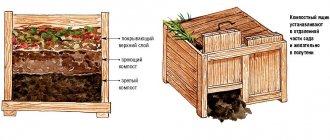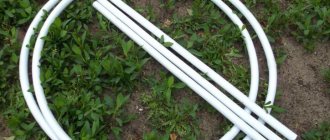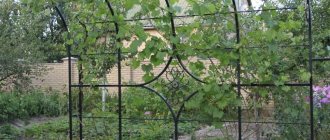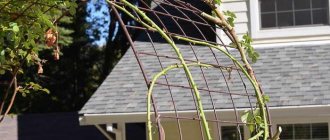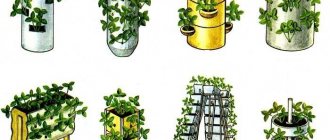How to choose a support for clematis
Before choosing the design and material of the support support, you need to decide what the flowering plant should look like.
Not all clematis grow above 2 meters. Tall, unpretentious clematis are suitable for complete decoration. The vine should be planted on the south side; its flowers will always face south. The location of the support should be such that a decorative screen made of flowering vines (arch, trellis) pleases the eyes of the owners of the house (dacha), and not the neighbors. A graceful plant requires an appropriate support structure. The best material for supporting flowering clematis: chain-link mesh, metal perforation, wooden picket fence, metal tubes. The mesh used must be painted or coated. This will protect it from corrosion and make the structure decorative.
The types of supporting supports depend on the clematis variety and material. Shapes made of mesh and metal or wooden rods can have the most bizarre character: a ball, a cone, a cube, a circle. The choice of material and design depends on the imagination of the builder and the type of clematis.
Types of wooden and metal load-bearing supports for vines:
To create cylindrical landscaping, varieties of clematis are used that do not cling to support during growth.
When choosing the type and material of the support support, you must remember that it will be closed in the warm season. The design of the support should not spoil the appearance of the site on other days when the plant sheds its leaves or is pruned.
The supporting structures of tall vines must be stable and support their weight and the heaviness of the stems and leaves. Such supporting supports are buried in the ground to a depth of up to half a meter, followed by soil compaction or concrete. This measure will help the support to withstand strong gusts of wind.
When determining the dimensions of the supporting structure, it is necessary to take into account:
- clematis height;
- arrangement of flowers (at the top, along the entire length);
- bud size.
A vine on a high support will grow, turning its flowers to the south. It should be taken into account that tall clematis have smaller flowers than medium- and low-growing species. The height of the supporting support depends on the varietal characteristics of the vines: it should not be much higher than the flowering clematis.
The high arch is suitable for fast growing plant species. Other varieties of clematis curl the arch after 8 -10 years
Clematis up to 1.5 m do not need high support for support. A small openwork stand welded from reinforcement and a wooden support made from slats will do for them. Large-flowered varieties of clematis are suitable for creating single cylindrical compositions, low arches, carpet screens (an area of 4-5 m2 and a height of up to 3 m). Cascades and garlands will be made from tall vines blooming at the ends of the shoots
How to tie flowers to a support correctly
If the support has not yet been erected on the site, then begin installing it yourself before planting the clematis. When the planted vine puts out its first shoots, they are immediately wrapped around the horizontal lower element of the trellis. Growing stems are gradually guided along vertical slats and help to catch on to higher horizontal bridges.
If clematis is not able to firmly fix itself to the support, the stems are constantly tied with fishing line as they grow. It is not advisable to use wide ropes made of fabric, as they spoil the appearance. The stems are arranged evenly along the trellis in a fan, do not allow them to intertwine.
Cylindrical mesh
A similar support for clematis is constructed from the same mesh. Most often it is used when you need to decorate unsightly elements, for example, pillars, dry tree trunks and other objects that can spoil the overall appearance of the garden.
Materials for construction:
- metal grid;
- 2 metal fittings;
- metal wire.
Sequence of work:
- 1You need to fasten the mesh along the edges to make a cylinder; for this you will need wire.
- 22 reinforcements are welded on opposite sides of the mesh so that they can be dug into the ground to a depth of 0.5 m.
- 3The mesh is painted with enamel; it is advisable to apply 2 layers to prevent further corrosion. It is advisable to select enamel in green tones so that the mesh blends with the plant.
If the mesh is made not of metal, but of PVC, this option does not need to be painted. Just 2 planted plants are enough for them to completely intertwine the metal mesh.
Making a support for clematis: making an arch and a wooden trellis
Beautiful plants, strewn with a scattering of star-shaped flowers, decorate most suburban areas. Graceful stems of clematis, climbing a trellis or support, form openwork screens, topped with many elegant flowers of the most incredible shapes and shades. These beautiful plants are used mainly for vertical gardening, and they can be most decorative only if they are placed on a support. Therefore, a do-it-yourself support for clematis is an integral element of the competent organization of vertical gardening in landscape design.
Why do “grandfather’s curls” need a support?
Lozinka, clematis, grandfather's curls, warthog are colloquial names for clematis. The variety of varieties and species, elegant, bright flowers have made this flower popular among amateur gardeners. Herbaceous, semi-lignified, lignified - clematis, for the most part, belong to climbing plants.
The mesh is an excellent support for plants
The general requirements for the growing season of all types and varieties of clematis are:
- good illumination of the growing area;
- opportunity for the development of the root system;
- wind protection;
- protecting plant shoots and roots from frost.
It is not always possible to fulfill these conditions if the plants are planted near a fence, the wall of a house or other structure.
When planting a plant near a house, the distance should be such that runoff from the roof does not fall on the roots of the vine, otherwise they will get wet. The foundation of the house will prevent the formation of the clematis root system and absorb water from irrigation.
Clematis require moisture depending on summer temperature and precipitation. Feeding flowering plants during the growing season will give good growth and strong shoots. Planting vines close to solid vertical surfaces can interfere with flower care.
Semi-shrub and shrub vines that produce strong growth develop poorly without stable support and do not bloom when they are in partial shade. A strong wind will break the grown thin stems of the plant, the thickness of which does not exceed 2-5 mm.
Types of supports for flowering clematis
Depending on the shape of the support for clematis, there are:
- Arched;
- Pyramidal;
- Fan designs.
The main requirements for them are: decorativeness, ease of installation and ease of use. Thanks to the supports, the clematis stems do not break or trample. Using vertical stands, you can provide ventilation to plants, which is the key to their rapid development and abundant flowering. An arch is the most common type of garden support for beautiful flowering plants.
A support entwined with flowering clematis, in addition to being an elegant element of decorating any garden, helps to divide the space into separate functional zones
The arch entwined with clematis, installed at the beginning of the path, looks simply amazing. She seems to invite you to stroll along the winding paths of the garden and immerse yourself in its enchanting beauty.
Clematis also feel comfortable on pyramidal tripods made of reeds, or metal or willow rods.
Pyramid supports provide good support for the flexible stems of the plant. They look appropriate both in multi-tiered flower arrangements and as a free-standing structure
You can create a cozy, romantic corner in the garden, where you can retire on a hot afternoon or a cool evening, hiding from the prying eyes of passers-by and enjoying the enchanting beauty, with the help of trellises.
How to make a support for a clematis flower with your own hands - description
The support for clematis must be strong, since they are characterized by rapid growth and the accumulation of a fairly large mass, which increases several times after heavy rainfall.
REFERENCE: A distinctive feature of the leaves and petioles of young clematis is the ability to grasp a support. Old leaves do not have this feature.
It is necessary to choose a support taking into account this feature: parts of the support should not be more than 10-20 mm in diameter, otherwise the plant will not be able to grasp the support. Give preference to supports with rough surfaces. It is allowed to use both a ready-made support or trellis, and one made by yourself.
How to make a wooden trellis for clematis?
Technology for constructing wooden supports:
- Dig the timber into the soil 40-50 cm deep, at intervals of 60 cm;
- Sew the distance between the beams with a mounting strip: figured or classic checkered;
- Using two small slats, an internal frame is formed;
- The remaining 12 slats are used to make a lattice;
REFERENCE: To make the structure strong and stable, it is necessary to make fasteners between the frames and nail a horizontal bar on top.
Paint the finished structure with varnish or paint.
Other ideas
You can make a support using available tools quickly and without any special financial investments:
- Stick the poles into the soil with their pointed ends and place them in a vertical position, forming a circle;
- The poles are closely intertwined with twigs or vines;
REFERENCE: Make two such rings; when planning a vase-shaped support, the rings should have different diameters.
After determining the position of the rings, they are fixed using twine. If necessary, adjust the height of the poles.
Making a cone support for miniature varieties:
- Mark a square on the ground;
- Stick long strong sticks in the corners;
- Add more sticks around the entire perimeter;
- Connect and tie all the tops;
- Using small sticks, make a lattice.
REFERENCE: Coarse mesh netting is also suitable for making supports.
Stretch a mesh between two dug-in posts and secure it with wire or hooks. Give preference to galvanized or plasticized chain-link. In a short time, the plant will curl the entire mesh, and the living flower wall will completely hide the chain-link. The walls of gazebos, bathhouses or summer kitchens can be used as support. For this purpose, it is necessary to drive nails or fasten hooks into the upper part of the wall, and tie the plants growing below with twine and fasten them to them. Plants are tied 20 cm from the surface of the ground to avoid their fracture as a result of exposure to adverse weather conditions. Also, clematis are planted half a meter from buildings, this will prevent the plants from overheating and protect them from water that drains from the roof.
Self-construction of an arched support:
- To make an arch you need a metal rod (diameter 10 mm) and 4 pieces of pipe (diameter 4 cm);
- First, by welding, connect the two halves, which, after manufacturing the structure, are bolted together;
- Install the pipe sections necessary for making the arched support into the ground and fill with concrete mixture;
- Using the same principle, install arched structures along the path at intervals of one meter. To create additional support for the clematis, weld transverse strips with a one and a half meter distance between the arches;
- The finished arch is painted green.
Types of supporting structures
To understand how to make a support for clematis with your own hands, you need to study several options for these structures. Each type of support has its own advantages.
- Metal supports for clematis are more demanding and difficult to produce. After all, their production requires skills in working with a welding machine.
- Wooden trellises or mesh stands are an alternative option for those people who do not know how to work with metal.
There are several popular types of clematis supports.
Metal grid
It lasts a long time and is reliable. You can make a trellis from reinforcement and mesh. The main material can also be wooden blocks. The garter to such a support must be fanned out so that the flowers of the plant are evenly distributed over it.
Rope support
Made from plastic pipes, various cords or ropes, a bicycle wheel and wire hooks. The main advantage of this design: clematis is easy to prepare for winter. To do this, you just need to remove the ropes. Then you can immediately begin preparing the plant.
It is made from a plastic pipe and a rope trellis. The edges of the pipe, bent into an arc, are installed on reinforcement buried in the ground. Since people will be moving under the structure, it must be of an appropriate size. The vault can be made in various shapes.
Tripod
This design is used not only as a support for clematis, but also for marking it. Wooden slats or metal rods can be used as materials for making a tripod. Such a structure can become a decoration for a summer house, especially if there is no house wall or gazebo.
Support made of wooden planks
It makes it possible to implement original ideas, for example, bars on the wall of a house. However, such a structure has a short service life. Moisture accumulates under the plant, causing the tree to rot and the structure to lose its strength.
Keep in mind that a support made of thin rods will be too fragile.
Do clematis need to be covered for the winter?
In order to prevent freezing of the lower bud and roots, these vines need to be protected from frost. Therefore, before covering the shoots, we remove all the leaves from them to prevent rotting. Then we remove the mulch at the base of the bush and fill the neck of the vine with compost or peat. After this, we lay out the stems in a circle in a ring, fasten the stems to the ground with thick wire clips, cover the top with mulch and cover with waterproof material, leaving holes for ventilation. In early spring, we free the shoots and tie them to a support.
For all their beauty, clematis frighten some summer residents with the difficulties of growing and caring for it. But, if you care for this amazing liana correctly, then you will be able to grow wonderful and luxurious flowers in the country, which look especially beautiful paired with climbing roses.
Purpose of the support
Clematis can reach a height of 3.5 m. Therefore, having support to support the shoots is a necessity. An adult plant is quite massive and unable to support itself. However, this is not the only reason why support is required. There are others:
- when positioned vertically, clematis looks much more attractive;
- Basically the bush develops densely. If properly fixed, the vine will not be susceptible to disease. And slugs and snails will not damage it;
- caring for a plant on a support is easier and more convenient. Watering and fertilizing, as well as pruning, can be done without much difficulty;
- The supporting structure itself is already a kind of decor. The beauty of clematis is revealed when the plant is covered with foliage and flowers. In cold weather, the support remains completely open. Therefore, it should also look beautiful regardless of the time of year.
Overview of species
Every owner dreams of creating a cozy corner in their garden plot, where they can not only relax, but also hide from the hot rays of the sun. You can create it in different ways, including using clematis placed on supports of various shapes. It is worth considering the most common ones among them and choosing the option that is most suitable for a particular garden plot.
Lattice
The most common and simplest option is a trellis made in the form of a lattice. You can buy it or make it yourself. If we consider the design in general, then the main part of the grille consists of a fairly strong frame. Inside, most often there are figures in the form of rhombuses or squares.
As for the size of the cells, according to standards they should be within 5 by 5 centimeters. These grilles can be installed as a stand-alone structure or attached to a wall. In the first case, the support will need support so that it does not fall from strong gusts of wind. But in this case, the support should also have an attractive appearance and not stand out too much from the general background.
Ball support
Clematis will look very beautiful if a ball-shaped supply is used to support it. In addition, this option is very convenient, because you can install such a support anywhere: in a flower bed, in the garden, and even near the terrace.
Most often, it is made from several curved rods, and its pin legs can be deepened into the ground, which will give it stability. The material used for its manufacture can be metal-plastic or aluminum tubes, which have the ability to bend well.
Support cylinder
With the help of such a structure you can decorate any vertical objects. These can be electric poles or dried tree trunks, which ultimately create the appearance of flowering poles. Their height should be within 2 meters.
An iron mesh can be used as a material for the manufacture of such a cylinder. It must be twisted into a cylinder and secured with ordinary wire. It is necessary to weld reinforcement to it from the sides, and then use them to dig the entire structure into the ground.
Arch
The forged arch looks very beautiful. It can be placed at the entrance to the yard or used to create a place to relax. Most often, such a structure is made from iron pipes or metal. In order to make a semicircle, you will need reinforcement that needs to be bent. The arch should be high and wide. This is necessary so that both a table and chairs can fit under it. Around such an arch you need to plant several clematis bushes. The composition will look very beautiful if the flowers have different shades.
Pergola support
It is a horizontally or vertically installed canopy, which is subsequently braided with clematis. Most often, a pergola is made from very thin wooden planks. This could be one or more broken frames. It can be placed on the site either as an independent structure or near a wall.
Obelisk support
Many gardeners call structures made in the form of pyramids obelisks. They are made from iron rods or wooden planks, which are fastened together with special crossbars, as a result of which they are very stable. You can install such structures in the most unusual places, for example, in flower beds, in the garden or even near the terrace.
Support with cord
It can be made from ordinary ropes or dense threads that are quite capable of supporting the weight of a clematis bush. Such supports have some advantages. For example, when you need to prune, the vines can be easily removed from such supports. After all, they will slide off without much effort and will not be damaged.
Trellis support
This design is the same trellis, made in the form of a lattice. Its only difference is that it consists of several sections. The most popular option among gardeners is the design that is made of 3 or more sections. Each of them is collected separately. The cells of the central section are made in the form of rhombuses, but the side ones are made in the form of squares of the correct shape.
All these sections must be connected to each other into one wall. Above the middle pillar you need to install a small semicircle that will look like sun rays. The trellis must be carefully secured in the ground using guy wires, which must be very strong. After all, such a structure, together with flowering clematis, will weigh quite a lot.
Tips for beginners
If a novice handmaker takes on the construction of a support for clematis for the first time, you should not mount a structure made of metal pipes, reinforcing rods or chain-link mesh. To perform such work, certain skills are required, the ability to handle professional tools (welding, grinder).
To begin with, it is better to use a garden wooden ladder, making a kind of trellis out of it. You can install an ordinary stepladder in the middle of the flowerbed, which will replace the pyramidal structure. You can simplify the work of assembling a support for clematis by using a bed net from a disused old metal bed. It is enough to make a support, install a part of an outdated bed at a slight angle, placing it vertically or horizontally, and carefully fasten plants strewn with flowers on the surface of the vine.
It is no less easy to assemble a support from wooden blocks, giving it any convenient shape. To work, you will need to prepare a sufficient number of wood screws, a drill and a hacksaw (if the workshop does not have a circular saw).
It is important to remember that clematis will look beautiful if its lashes are evenly distributed and the cells of the structure are small.
When choosing the type and shape of support for clematis, you should take into account the design style of the site. Only in this case will the arch or wall successfully fit into the overall design and the climbing flower will become a real full-fledged decoration of the garden, recreation area or other place in the courtyard of a country house.
Description and varieties of clematis
The genus Clematis, according to some sources, has about 380 species. These are shrubs, subshrubs and herbaceous vines. Today we will look at the most unpretentious clematis varieties adapted to central Russia, which require pruning at the end of the season. To decorate the site, the following varieties are most often grown:
- “Tuchka” is a vine up to three meters long with purple-violet flowers. Can be planted near fences and trellises. Able to climb bushes and form arches.
- “Solidarity” is a variety with bright red buds, the diameter of which reaches 16 cm. It is used for framing trellises, nets, and arbors.
- “Cardinal Vyshinsky” is distinguished by its resistance to frost, compactness and bright red inflorescences. The variety is most often grown in flower beds and containers.
- “Ballerina” is a liana that even beginners in floriculture can grow. This plant is not afraid of diseases, pests, and temperature changes. In addition, it blooms profusely and for a long time.
- “Integrifolia” is a herbaceous group of clematis up to one and a half meters high with a powerful skeletal part and abundant flowering. The bush produces many lashes that can be used to wrap around hedges. But at the same time, the lashes must be tied up, since they do not cling to the supports at all. Intergriforia flowers, up to 12 cm in diameter, can be pink, bright red, dark red, or purple.
- “Alyonushka” - a variety with bell-shaped flowers can be intertwined with other plants and used as ground cover or balcony decoration.
- "Jacmana" is a hybrid developed by crossing several plant species. The liana grows up to 4 meters in height, is characterized by winter hardiness, large leaves and purple flowers.
- "Nelly Moser" is a variety that grows well and blooms in the shade. The flowers are lilac-pink. The vine does not grow very quickly, but it requires support. It is a good option for trellises, gazebos, pergolas.
- “Piilu” - clematis bred in Estonia gained popularity in Russia for blooming with both regular and double flowers on one bush. The vine will grow up to one and a half meters in length. The petals of its flowers are lilac-pink.
- “Burning” is a highly ornamental plant that is not afraid of frost. Excellent for growing in the Northern regions.
Features of growing clematis
Thin vines strewn with many beautiful flowers are welcome guests in many areas. Blooming at the beginning of summer, they are able to delight with amazing flowering throughout the season.
Large-flowered varieties, capable of covering an area of up to 4-5 meters, act as an elegant decoration for the front areas of the site: the walls of the veranda and gazebo, the central entrance and front garden
Small-flowered varieties of clematis are excellent for shading the facades of buildings, grottoes, stairs and unsightly buildings.
A clematis hedge, like a woven dense carpet of thousands of marvelous flowers, can not only transform an area, but hide it from the prying eyes of passers-by
Clematis are plants that prefer sunny areas, but require shading of the root system, in simple words “head in the sun, and feet in the shade.” The second no less important condition for growing these beautiful flowering plants is placing them on supports. Properly selected supports for clematis will allow you to give the compositions the desired shape and demonstrate the decorative qualities of the plant.
Clematis most often act as the center of vertical gardening design. When choosing plants to decorate a site, it is advisable to take into account the biological characteristics of a particular variety. If you want to create falling “cascades” or elegant “garlands,” it is better to opt for varieties whose flowers are more concentrated at the ends of the shoots, for example: Serenade of Crimea, Biryuzinka, Alpinist. When decorating “carpet” compositions, it is better to give preference to varieties whose flowers are evenly distributed along the vine: Cosmic Melody, Alyonushka, Gray Bird.
You can learn about other types of unpretentious vines for the garden from the material: https://diz-cafe.com/ozelenenie/liany-dlya-sada.html
Why does clematis need supports and the requirements for them?
During the growth process, almost all types of clematis tend upward. Therefore, for their normal development and subsequent flowering, it is necessary to equip appropriate devices to which the leaf petioles will cling. The designs of supports for clematis can be very diverse: from ordinary ropes stretched lengthwise and crosswise on the wall of a house, to complex architectural arches framing the front door or gate.
During periods of rapid development and lush flowering, these plants gain significant weight, which increases even more after rain. Therefore, regardless of the design features, the supporting devices must be strong enough to withstand not only the mass of the plants, but also an additional significant load.
And, of course, the appearance of the manufactured devices plays an important role, because flowering plants will hide the details of the structures from view only during the growing season. Therefore, the rest of the time, the supports should not introduce dissonance into the overall aesthetic picture of the design of a personal plot or garden.
Materials for supports
When choosing the most suitable support for clematis, you need to take into account the beauty of the future structure and the convenience of weaving a flower along it. For support, wire, mesh, or lattice will do, from which you can assemble a pyramid or other figure.
Props in the country can be made from the following materials:
- metal. The structure is made of metal mesh or reinforcement by welding. This design is reliable and holds its shape well. In addition, it is easier for the plant to cling to thin twigs;
- forging. Forged elements always attract attention in everything, and flower supports are no exception. The product will not be cheap, since it is unlikely that you will be able to create it yourself: you will need not only special equipment, but also skills. However, in winter such a support will really decorate the garden;
- tree. You can create any structure with your own hands from wood, for example, trellises, gratings, etc. The material has one drawback - fragility. Since clematis is a rather dense plant, moisture is retained inside the bush, which leads to rotting of the wooden support. Basically, trellises are constructed from planks that are difficult for the plant to cling to. Therefore, the vine needs periodic garter;
- net. The most accessible materials are rope, fishing line, and wire. They are stretched out in a way that will be convenient and beautiful. It is easy to create openwork frames from such flexible materials. The base is made of strong wire, and sections of the structure are tightened with fishing line.
Clematis in landscape design
To decorate the garden, hybrids are most often used, which do not require shelter for the winter and radical pruning. Every year, landscape designers offer more and more solutions for decorating a site with a variety of clematis:
- Lianas can be used both for vertical gardening and as a colorful carpet on the lawn.
- Some not very tall varieties that do not need support can grow in flowerpots and boxes, decorating verandas, gazebos, balconies and loggias.
- By planting several types of clematis near the arch and intertwining them, you can get a beautiful multi-colored entrance to the garden or plot.
- Soft colors in the background will highlight the personality of the roses, which can be planted in front of clematis.
- Bare tree trunks will look beautiful if they are entwined with flowering vines.
- The original zest of the alpine hill will be given by the lashes of plants that will seem to crawl over the stones.
- Plants with large flowers look most impressive near low walls, in central flower beds, in front gardens and ceremonial places.
- The shady alleys that are located in the background of the garden are decorated with bright, colorful flowers.
But most often, clematis are used to decorate fences, arches, gazebos, hedges, and walls. On hot days, on the veranda or in the gazebo, which is entwined with vines, you can escape from the scorching sun.
It will be useful for everyone to learn about the variety of unpretentious, long-blooming perennial flowers for the garden with descriptions and photos.
Clematis and roses
The growth and flowering conditions of roses and clematis are approximately similar. This is probably why the British love to grow these gorgeous plants together.
However, clematis grow a little faster, so roses are planted first, which will serve as supports for the vines. When planting these plants, you must follow some rules:
- It is better to plant clematis varieties with small flowers to climb roses;
- when planting, the vine needs to be slightly tilted towards the central part of the rose bush;
- plants are planted and cling to supports so that they do not interfere with each other, and each of them is able to enjoy the sun's rays;
- you should choose varieties that have approximately the same height and volume;
- It is recommended to place a partition between the roots of the seedlings;
- Only those roses that are well adapted to the area are planted.
Clematis can simply be planted on the ground between the roses, and over time it will grow around the bushes. Each gardener can independently choose his own combination of colors.
- To make the composition bright, you can add vines with crimson flowers to white roses.
- Pink roses and blue clematis will look tender.
- Vines with purple and violet flowers pair well with yellow roses.
- Red roses will stand out among the delicate buds, and any bright flowers will suit tea roses.
Clematis with other flowers
The neighbors of a lush vine can be:
- coniferous plants;
- black elderberry, fragrant acacia, willow pear, willow, hops;
- Mackerel, barberry;
- buddleia, hydrangea, viburnum, forsythia, spirea;
- grapes, jasmine;
- lilies;
- mock orange
When growing clematis, it is recommended to shade their roots, so calendula, marigolds or other plants with shallow roots are planted around them. Geraniums, irises, astilbes, and phlox look beautiful against the background of vines.
How to tie clematis so that it curls beautifully along the support
Many people wonder how to tie clematis so that it effectively and beautifully entwines the support. The flower must be tied evenly. The garter is made in one layer. Light should pass freely to all parts of the bush. Twine or raffia is used in the process.
Clematis is a plant that is often used to decorate the garden. This vine definitely needs support as a support so that it develops well and looks impressive. You can buy a ready-made support in a store or make it yourself. How to do this was described above.c
What you need to create a support for clematis
For example, the varieties “Yubileiny 70” and “Cosmic Melody” are suitable for creating carpet-type compositions. During flowering, their flowers are arranged evenly from the root to the top. The varieties “Serenade Krima”, “Biryuzinka”, “Alpinist” are used as garlands and cascades.
If you plan to use a cylindrical support, use varieties that do not cling during growth: “Grey Bird”, “Memory of the Heart”, “White Dance”, “Anastasia Anisimova”, “Alyonushka”.
When planting clematis and deciding which support to choose, keep in mind that it will be covered by the plant only in the summer. The rest of the time, its support will remain uncovered. Therefore, make it so that it fits beautifully into the design of your garden even without a plant.
It is also necessary to take into account the peculiarities of the soil on which the structure will be installed, because the fastening must be reliable and capable of supporting the weight of an overgrown plant.
As for the material for creating a “stand,” it depends on what type of clematis supports you choose. These can be metal or wooden gratings made of slats, arches and stairs made of metal or wooden rods, a metal grating or simply a rope running along a given perimeter. They can be attached to walls, to decorate paths, windows, entrances, to decorate trees or specially installed poles.
Wicker support made of twigs
To make the structure you will need twine, an ax, willow twigs or vines, and several pairs of high poles.
The poles are pointed at the bottom and stuck vertically into the ground where clematis is planned to be planted.
Two rings are woven from branches or vines of such a size that they can be pressed tightly against the poles.
How to make trellises using wooden beams
To do this, you need to take wooden slats and bars up to 5 cm thick. From the bars, make a frame on which slats are placed in the form of a lattice.
Horizontal ones are applied on the front side, vertical ones, which go perpendicular to the first layer, on the back side of the frame. They are fixed with self-tapping screws or glue, but it is with the help of self-tapping screws that it is necessary to secure the places where the slats intersect (this is more reliable).
Now you need to secure the support pillars at the place where the trellis is installed. If clematis is planted near a path and a trellis is placed on it, then they are secured with metal corners. The same corners must be used to attach the trellis itself to the posts. To make the structure reliable, additional supports are installed. For example, if the trellis is located near the wall of the house, it can be supported on the wall with additional beams.
Creating a support for clematis from a chain-link mesh
If you do not have the desire or ability to create decorative structures, a support for clematis can be made with your own hands in other, simpler ways - gardeners have many ideas for this. For example, you can install a regular chain-link mesh. It is simple, economical, but no less impressive when the plant entwines it.
So, to create such a support you will need a chain-link mesh of the required size, thin metal wire, three plastic or any other thin supports and an old electrical cable (or something that can replace it). Also have pliers and a screwdriver ready for the job.
Two of them are located on the sides, and one is on top of the grid. First, the side supports are threaded into the mesh stretched over the cable so that about 20 cm of the end free from the mesh remains at the bottom. This part of the support will go into the ground. The third support is threaded through the top of the mesh to give stability to the structure. At the junction points, the supports must be secured with thin wire.
Now the structure must be installed in the chosen location, usually near the fence. The legs are immersed in the ground at a distance of about half a meter from the fence, and the top is leaned against it and secured with screws.
The clematis plant is often used to decorate the porch, and the question “How to make a support in this case?” is solved extremely simply. Trellis are formed from cord or wire, which are attached under a canopy or above a door with one end, and the other - to a peg driven into the ground next to the bush.
How to make an arch for clematis
To do this, you will need two long duralumin tubes (about 3 m), five short ones (about 0.5 m), welded mesh in PVC insulation, enamel and stainless screws.
Now we measure two sheets of mesh so that their width is two cells larger than the width of the installed structure, but the length must match exactly. Along the edge of the mesh, wire cutters form protruding rods (about 40 mm), with which it is attached to the arch. Having securely twisted each of them around the duralumin tube, install the arch, plunging its base into the ground about half a meter.
Types of supports and materials for making them yourself
You can make a support stand for clematis with your own hands using several methods. After studying them, the owner of the site can choose the most suitable one.
Material for making supports
DIY money tree bonsai
Quite often, when creating flower stands and trellises, materials left over from renovation work are used. Most often used in garden structures:
- wooden slats and boards;
- metal pipes and pieces of fittings;
- plastic mesh or pieces of chain-link;
- old doors and window frames.
Note! After carefully looking at the items stored in the garage or closet, some summer residents create supports from old wheels, furniture parts, fishing accessories, wire, and linen cord. Branches, twigs, and vines are also often used.
Wooden pergola
A pergola is a lattice canopy made of slats about 5 cm wide, placed vertically or horizontally. Such partitions are often used to decorate openings in gazebos. It can also be attached to the wall of a building or installed anywhere on the site as an independent structure.
Wooden trellises can have different shapes
Arched metal structure
A metal arch for clematis lasts long enough and is able to withstand the weight of the overgrown lashes of the plant. You can extend the life of such a stand by regularly covering it with a fresh coat of paint or varnish.
Having the skills and welding equipment, you can make the structure yourself. If you lack the skills, it is recommended to opt for a chain-link mesh or a ready-made stand made of reinforcement. Interesting arched supports are widely available in specialized stores.
Do clematis need to be covered for the winter?
In order to prevent freezing of the lower bud and roots, these vines need to be protected from frost. Therefore, before covering the shoots, we remove all the leaves from them to prevent rotting. Then we remove the mulch at the base of the bush and fill the neck of the vine with compost or peat. After this, we lay out the stems in a circle in a ring, fasten the stems to the ground with thick wire clips, cover the top with mulch and cover with waterproof material, leaving holes for ventilation. In early spring, we free the shoots and tie them to a support.
For all their beauty, clematis frighten some summer residents with the difficulties of growing and caring for it. But, if you care for this amazing liana correctly, then you will be able to grow wonderful and luxurious flowers in the country, which look especially beautiful paired with climbing roses.
How to properly secure a plant to a support
The clematis lashes need to be directed in the right way so that they braid the support beautifully. To do this, young flexible shoots are first fixed to the bottom of the supporting structure using a thick thread, rope, twine or special plastic clips (sold in stores), and then directed upward in different directions or wrapped around the support element. Lignified branches are secured with wire. As the plant grows, it is periodically tied up, since clematis itself is usually unable to firmly fix itself. Interlacing and overlapping of stems should not be allowed, otherwise they will be unevenly illuminated and poorly ventilated.
Young flexible shoots of clematis can be wrapped around a support
Small-flowered star-shaped white clematis grows near our fence, welded from a thin metal rod. In the spring, while the shoots are not yet very tall (20–25 cm), they must be taken apart one by one and carefully tied at the very base to the lower reinforcement bars. Afterwards, it is enough to only occasionally guide the stems; they crawl and cling with tendrils, then they are on their own.


